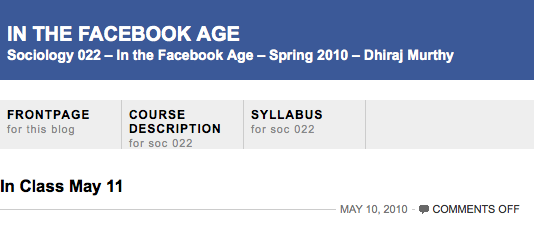How to help students with class-related blogs
 Following on from my last blog post regarding blogging in the classroom, I wanted to blog about ways to potentially help students with the challenges of class-related blogging. I wanted to share some techniques I have employed:
Following on from my last blog post regarding blogging in the classroom, I wanted to blog about ways to potentially help students with the challenges of class-related blogging. I wanted to share some techniques I have employed:
. Students often found it difficult to fit ‘everything’ into one blog entry. This is definitely a challenge for educators to clearly explain. However, it is an excellent way to develop concise writing and it should be emphasized to students. I have encouraged my students to think about one or two key points which are conveyed by the readings for that week. Then, I have recommended they focus on addressing those particular points rather than trying to bite off more than you can chew. Remember: less is more.
. Some students felt the pressure of linking blog entries to real-life examples, given the embedding and linking functions of blog technologies. To help with this, I recommended students subscribe/read online newspapers such as the New York Times, and The Guardian. Additionally, if students use Twitter, they should think about following @nytimes and @bbctech to give them a breadth of news stories they can link to.
. A tendency of many students when blogging is to summarize too much. To some extent, the medium makes this easy. However, encouraging students to take some time to reread their entries after they’ve written them and edit them produces miracles. That way their blog entry has elements of stream of consciousness, but is not merely a stream of consciousness summary.
. Some of my students found it difficult making blog entries coherent. One way I have suggested to them to tackle this is to always make sure every blog entry has a clear thesis statement. It can be easy to think of a blog entry as not ‘serious’. But, after all, if teachers are assessing blog entries, it is clear that expectations of structure are clearly conveyed. I suggested to my students that a thesis statement can also be worked into an entry after you have typed some initial thoughts down
. Another problem expressed is that blogs do not have as visible a limit like essays do (e.g. ‘two page paper’). As such, it can be difficult figuring out how to be concise. One suggestion for tackling this is for students to write their blog entries in the word processing program they usually write essays in so that they can ‘feel’ how much they have written. This has worked for some of my students in the past.
. It can be easy for blog entries to turn into a personal statement or tirade if they are not taken as a scholarly exercise. In that way, I recommend giving students methods to maintain a critical analytical approach when blogging (not always needed, but this can be a useful change!). One way to foster this is to ask students to play devil’s advocate when blogging (e.g. argue that if Facebook disappeared, the world would be a better place…). This forces students out of the blog as stream of consciousness mode and into a critical mindset.